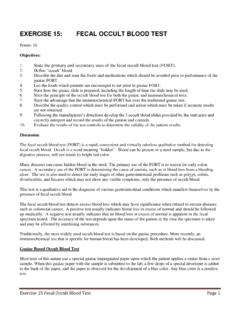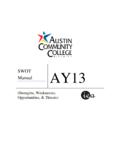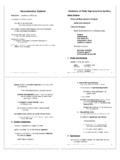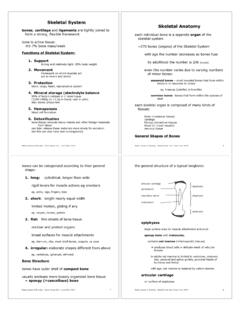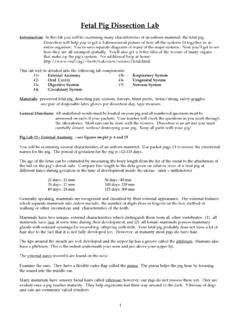Transcription of Introduction to Anatomy & Physiology
1 Biol 2404 Introduction to Anatomy & Physiology ; Lab Manual, Ziser, 1 Introduction to Anatomy & Physiology Lab Manual Stephen W. Ziser Department of Biology Pinnacle Campus for BIOL 2404 Introduction to Anatomy & Physiology Laboratory Activities, Homework and Lab Assignments Biol 2404 Introduction to Anatomy & Physiology ; Lab Manual, Ziser, 2 Biol 2404 Lab Manual Table of Contents I. General Laboratory Orientation .. 3 II. Lab Safety .. 5 III. Laboratory Activities & Homework Assignments 1.
2 Units of Measurement & Metric System Homework .. 11 2. The Language of Anatomy .. 15 3. Organ Systems Overview .. 17 4. Experiment: Identification of Organic Molecules .. 18 5. Microscopy .. 23 6. The Cell & Cell Division .. 24 7. Human Tissues & Tissue Identification .. 26 8. Dissection of the Fetal Pig.. 30 9. Body Membranes .. 35 10. The Integumentary System .. 36 11. The Skeletal System .. 38 12. Articulations and Body Movements .. 41 13. The Muscular System .. 43 14. The Nervous System .. 45 15.
3 Sense Organs .. 49 16. The Endocrine System .. 52 17. The Circulatory System .. 54 18. The Lymphatic System .. 57 19. Experiment: Hematology, Heart Sounds & Blood Pressure .. 59 20. The Respiratory System .. 64 21. Experiment: Measuring Vital Capacity .. 66 22. Experiment: Enzyme Activity .. 69 23. The Digestive System .. 73 24. Experiment: pH and Buffers .. 75 25. The Urinary System .. 82 26. The Reproductive System .. 83 27. A Survey of Human Development .. 85 Biol 2404 Introduction to Anatomy & Physiology ; Lab Manual, Ziser, 3 Biol 2404 Lab Orientation The laboratory portion of this course is designed to study anatomical details of each body system more thoroughly than it is presented in lecture.
4 While human models are also used, your core learning will come from your dissections and tissue studies. If you have a real moral objection to animal dissections then you should not take this course at ACC since you would not be able to learn some of the essential lab skills and would therefore be missing an essential part of the course. This method of hands on learning should also enhance and strengthen the knowledge you gain in lectures. At times you will be working individually, in pairs or in groups of three or four. Each lab period is loosely structured to begin with a short Introduction to the exercise that highlights the activities of the day, what materials are available for use and any changes in procedures.
5 After that you will work independently to learn the material. There is never enough time in lab to go over each and every item that you are assigned. The lab is a designated a time when you have access to materials that you will not have available during home study time. Some of the information assigned in lab you can learn at home, other items, particularly anatomical terms identified on dissected organs, animals and models and microscopic details viewed with a microscope can only be learned adequately in the lab room. General Lab Rules: 1. Read the lab exercise before you come to lab.
6 There is not time to review every aspect of each exercise and still give you time to work on your own. I will assume that you know what the exercise covers in general and I will only review changes or specific materials that you will use. 2. Before each lab, use the terminology list to mark the items in your manual s text and illustrations that you are responsible for learning. 2. Read and memorize the laboratory safety rules of the lab below. The preservatives are irritants and some of you may be allergic to them. Gloves must be used during dissections and will be provided.
7 Your dissecting tools will be provided for you as well. 3. The PIN lab room is open on Fridays, 8:00 am to 12:00 pm for extra lab study time. Dissections: Dissections are an integral part of the Anatomy and Physiology lab experience. There is no substitute for handling and dissecting real tissues and organs as a way to learn Anatomy : The term dissection means to expose to view . Many beginning students assume that dissecting automatically means cutting things up but actual cutting is rare and then it will usually be done with scissors, not scalpels.
8 Scalpels more often damage the material and make things harder to see and their use is discouraged in most cases. While you will occasionally use scissors to begin the process of dissection your primary tools of dissection will be forceps and blunt probes and fingers. Any dissections will be performed as a group. Typically one person reads the instructions and one or two other students will actually do the dissection. Your instructor will be watching to ensure that this is a shared project. Rolls should be rotated frequently. Generally, the person actually doing the dissection is the one who learns the material best.
9 Biol 2404 Introduction to Anatomy & Physiology ; Lab Manual, Ziser, 4 Dissecting tools and gloves are provided in the student drawers. Any dissected materials to be discarded must be placed in the designated container; NOT in the sinks. You will be expected to rinse your i tray, rinse and dry your pins and utensils and replace them where you found them and clean off your counter with disinfectant spray. Biology Lab Safety Procedures and Information Health and safety are paramount values in science classrooms, laboratories and field activities. You are expected to learn, understand and comply with ACC environmental, health and safety procedures and agree to follow the ACC science safety policy.
10 You are expected to conduct yourself professionally with respect and courtesy to all. You can read the complete ACC science safety policy at: All safety policies and procedures apply to scheduled lab classes as well as open labs. Consequences for not complying with safety procedures: 1. You will not be able to participate in a lab activity if: a. you are late for class and have missed safety training specific for that day s lab or field activity; b. you have forgotten your personal protective equipment; c. you refuse to wear personal protective equipment; d.


